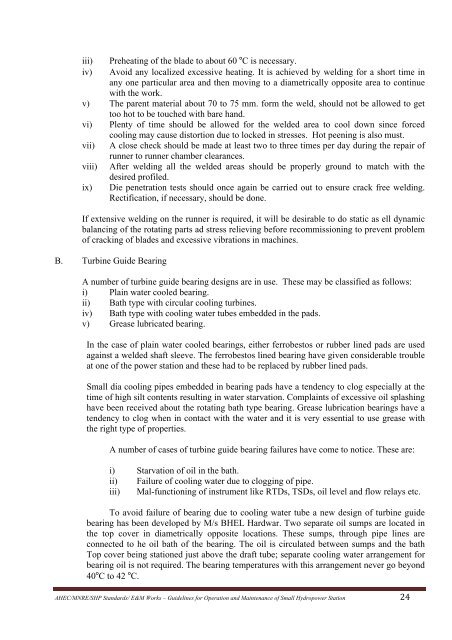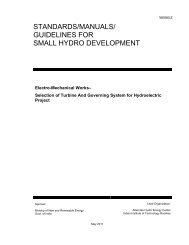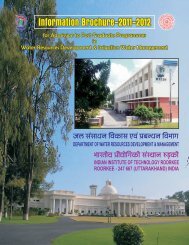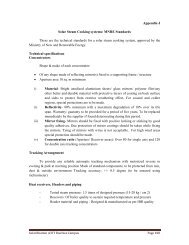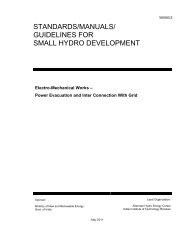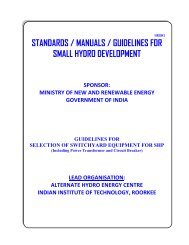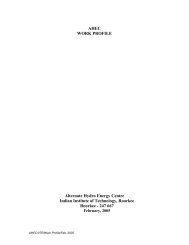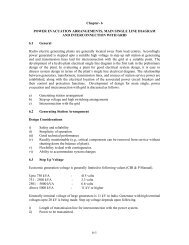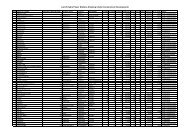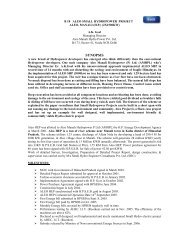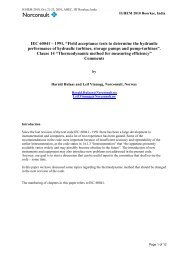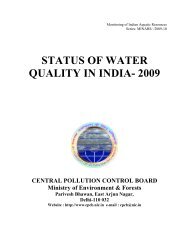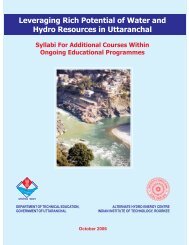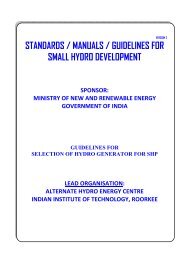standards / manuals / guidelines for small hydro development - AHEC
standards / manuals / guidelines for small hydro development - AHEC
standards / manuals / guidelines for small hydro development - AHEC
Create successful ePaper yourself
Turn your PDF publications into a flip-book with our unique Google optimized e-Paper software.
iii) Preheating of the blade to about 60 °C is necessary.iv) Avoid any localized excessive heating. It is achieved by welding <strong>for</strong> a short time inany one particular area and then moving to a diametrically opposite area to continuewith the work.v) The parent material about 70 to 75 mm. <strong>for</strong>m the weld, should not be allowed to gettoo hot to be touched with bare hand.vi) Plenty of time should be allowed <strong>for</strong> the welded area to cool down since <strong>for</strong>cedcooling may cause distortion due to locked in stresses. Hot peening is also must.vii) A close check should be made at least two to three times per day during the repair ofrunner to runner chamber clearances.viii) After welding all the welded areas should be properly ground to match with thedesired profiled.ix) Die penetration tests should once again be carried out to ensure crack free welding.Rectification, if necessary, should be done.If extensive welding on the runner is required, it will be desirable to do static as ell dynamicbalancing of the rotating parts ad stress relieving be<strong>for</strong>e recommissioning to prevent problemof cracking of blades and excessive vibrations in machines.B. Turbine Guide BearingA number of turbine guide bearing designs are in use. These may be classified as follows:i) Plain water cooled bearing.ii) Bath type with circular cooling turbines.iv) Bath type with cooling water tubes embedded in the pads.v) Grease lubricated bearing.In the case of plain water cooled bearings, either ferrobestos or rubber lined pads are usedagainst a welded shaft sleeve. The ferrobestos lined bearing have given considerable troubleat one of the power station and these had to be replaced by rubber lined pads.Small dia cooling pipes embedded in bearing pads have a tendency to clog especially at thetime of high silt contents resulting in water starvation. Complaints of excessive oil splashinghave been received about the rotating bath type bearing. Grease lubrication bearings have atendency to clog when in contact with the water and it is very essential to use grease withthe right type of properties.A number of cases of turbine guide bearing failures have come to notice. These are:i) Starvation of oil in the bath.ii) Failure of cooling water due to clogging of pipe.iii) Mal-functioning of instrument like RTDs, TSDs, oil level and flow relays etc.To avoid failure of bearing due to cooling water tube a new design of turbine guidebearing has been developed by M/s BHEL Hardwar. Two separate oil sumps are located inthe top cover in diametrically opposite locations. These sumps, through pipe lines areconnected to he oil bath of the bearing. The oil is circulated between sumps and the bathTop cover being stationed just above the draft tube; separate cooling water arrangement <strong>for</strong>bearing oil is not required. The bearing temperatures with this arrangement never go beyond40°C to 42 °C.<strong>AHEC</strong>/MNRE/SHP Standards/ E&M Works – Guidelines <strong>for</strong> Operation and Maintenance of Small Hydropower Station 24


